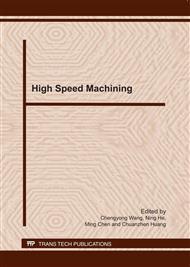p.15
p.21
p.26
p.32
p.38
p.43
p.49
p.55
p.61
Research on Wear Property of Tool Flank by Dry Cutting of Austempering Ductile Iron
Abstract:
Three different cutting tools (ceramics CC6050, cubic boron nitride CB7025, carbide GC2025) were used for dry cutting of 3 groups of ADI which were heat-treated separately under different quenching temperatures. With the unified cutting parameters, the wear of tool flank of each cutter was studied and the main influencing factors of the wear were analyzed. Results showed that when the cutting parameters ap =0.2mm, f =0.16mm/r, vc =108m/min and the cutting tool was determined, the higher the quenching temperature was the lower the hardness of the test bars were and the tool flank wear was less; When the quenching temperature was determined, the more the produced BUE (build up edge) of the cutting tool was the less the tool flank wear was.
Info:
Periodical:
Pages:
38-42
Citation:
Online since:
March 2011
Authors:
Keywords:
Price:
Сopyright:
© 2011 Trans Tech Publications Ltd. All Rights Reserved
Share:
Citation:


